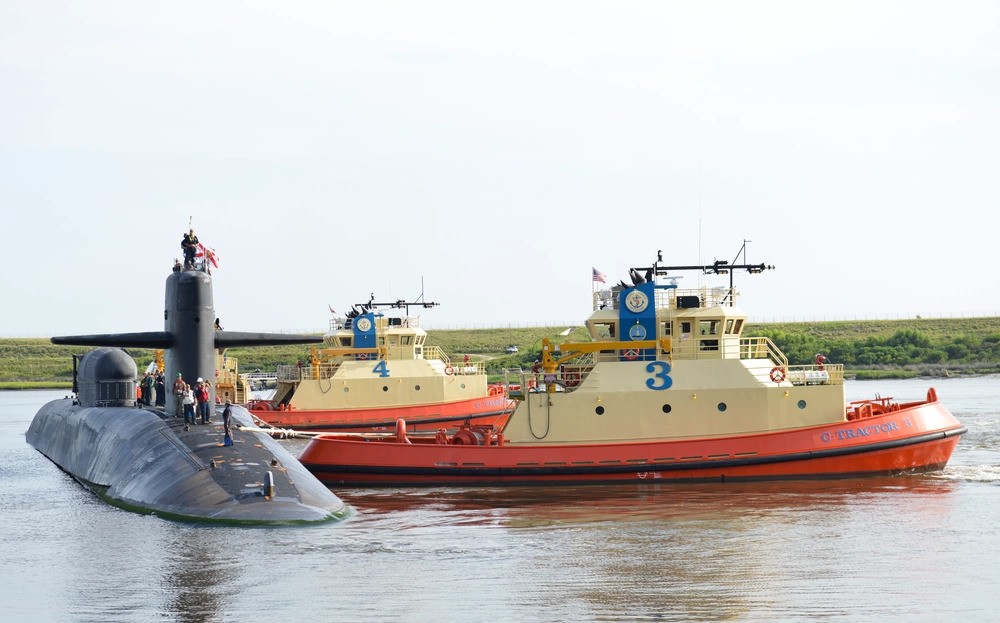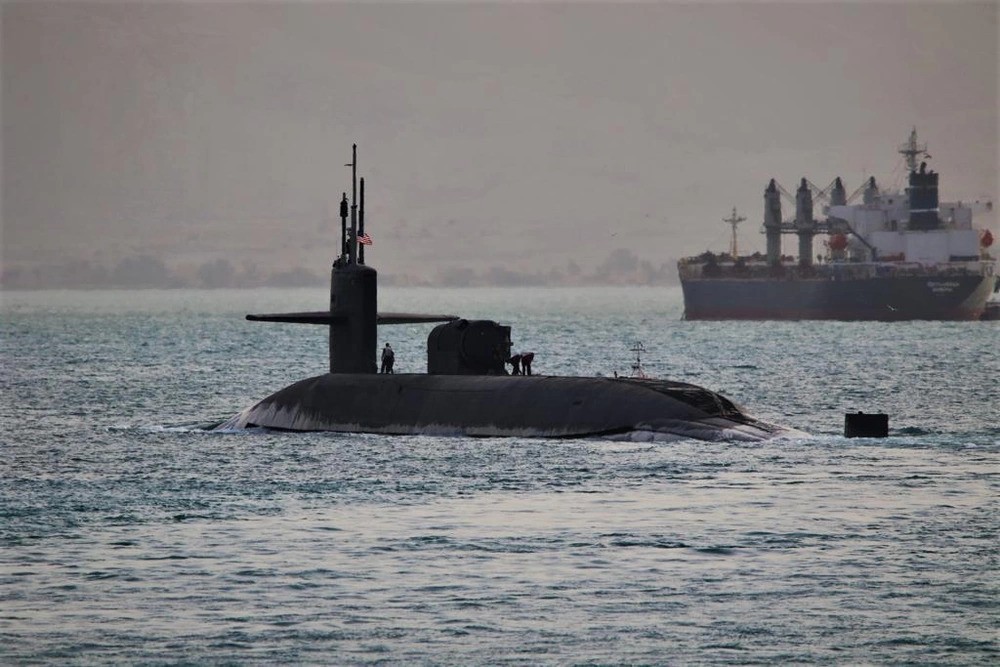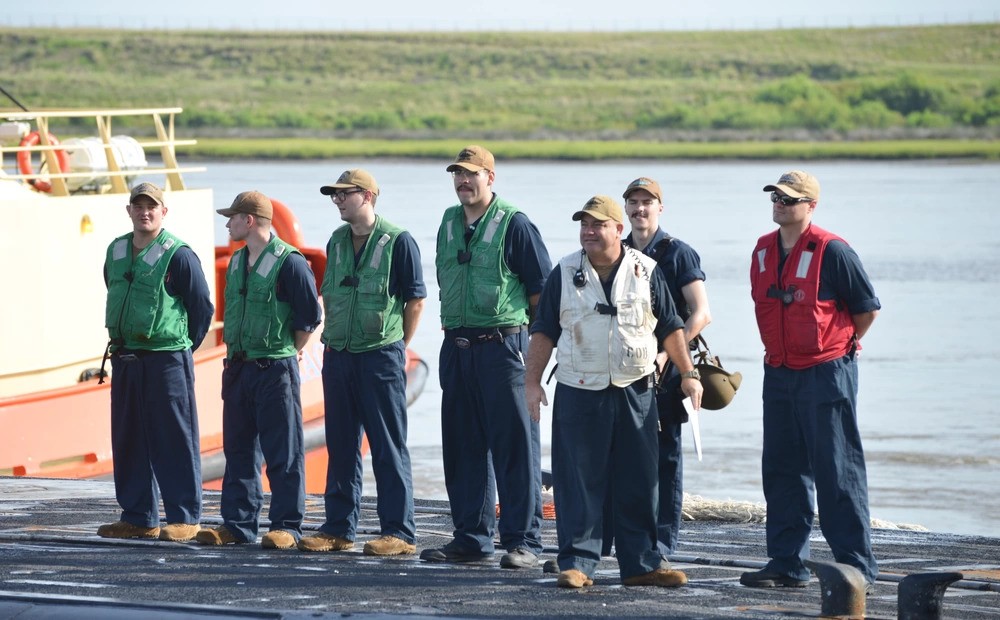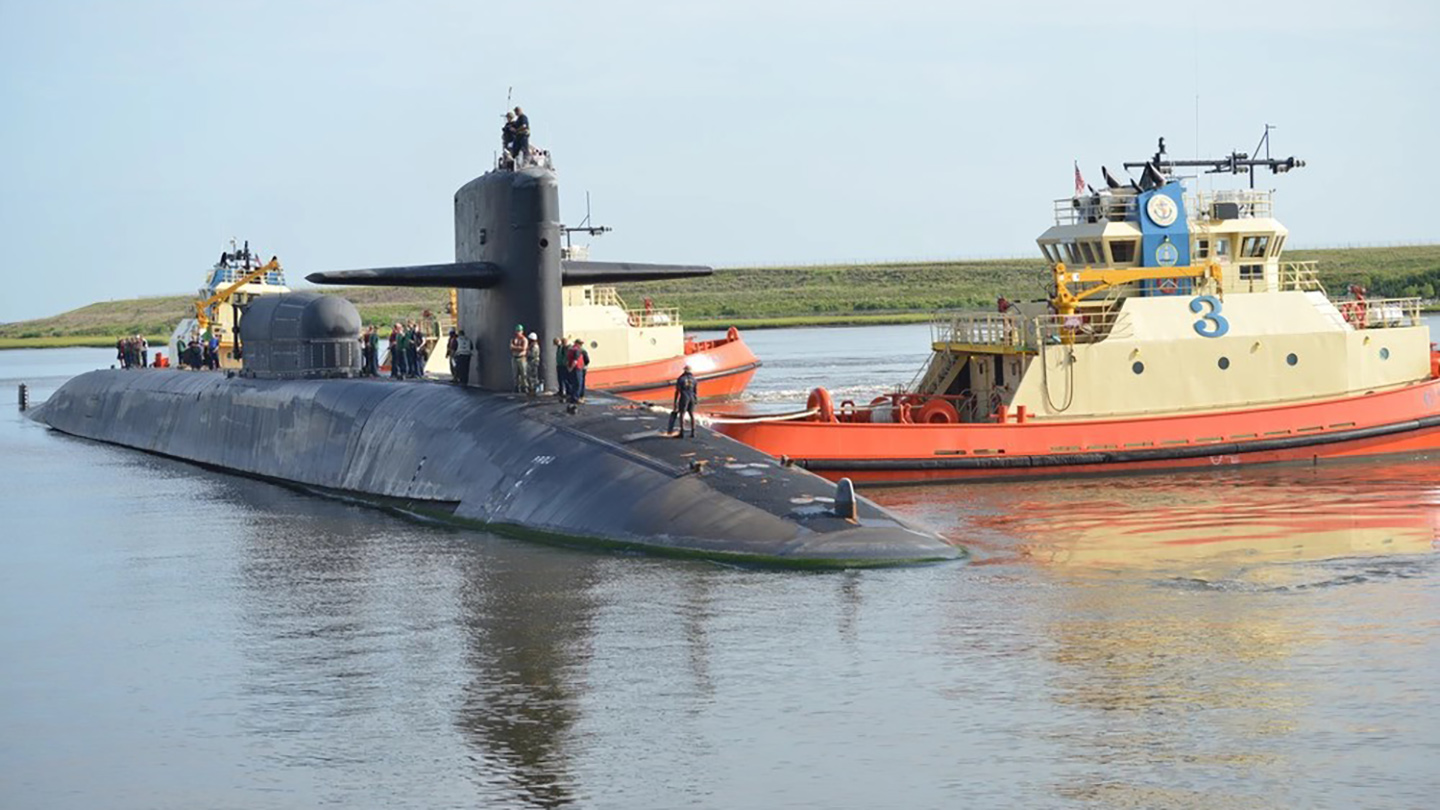The Ohio class nuclear-powered guided missile submarine (SSGN) USS Florida returned to its homeport of Kings Bay, Georgia this morning after 727 days deployed traversing more than 60,000 miles “undetected” around the globe. The War Zone had the unique opportunity to interview the commanders of the Florida to get an inside look at the 41-year-old but still highly-prized and very secretive submarine’s long patrol.
Nearly all of its missions remain unknown to the public, but Florida launched an unknown quantity of Tomahawk land-attack missiles (TLAMS) at Houthi facilities in Yemen on Jan. 11. It was part of an international response to the Iranian-backed rebel’s campaign of attacks on Red Sea shipping. That is customary for this type of operation if an SSGN is in the area. We noted Florida’s presence in the region back in October for this exact type of application.
“This was an unprecedented deployment, the first-ever Atlantic Fleet SSGN, to go to the Pacific Fleet,” Cmdr. George Thompson, Executive Officer of one of the boat’s two crews told a small group of reporters, including from The War Zone. “The Florida circumnavigated the world. That’s a unique accomplishment, being able to prepare for not only the 5th and 6th Fleet, like we typically do, but the 5th, 6th and 7th fleets [the Middle East, Mediterranean Sea, and the Pacific respectively]. For both crews to be able to operate worldwide, undetected for over 700 days, was a unique challenge that required the entire enterprise to come to bear to get us ready to do that.”

Thompson, along with Commanding Officer Capt. Peter French, and Chief of the Boat, Jerry Struble offered a rare glimpse by an Ohio class submarine’s leadership triad into the operations of one of the most powerful, in-demand, and flexible weapons in the U.S. arsenal. Large and stealthy, it can carry up to 154 TLAMS and dozens of Navy SEALs into contested territory to ply their quiet trade. The Ohio SSGNs can also launch undersea and aerial uncrewed underwater vehicles (UUVs). You can read more about the four boats in this class and how they came to be in our deep dive here.
The triad offered few concrete operational details about the deployment, but they did provide insights into what the boat brings to the table and what life was like for its crews during the long patrol.
In the wake of the Oct. 7 Hamas surprise attack on Israel, the U.S. beefed up its military presence in the region. That included moving the Florida. Last November, it arrived deployed to the 5th Fleet’s region covering the Middle East and crossed into the Red Sea, where it worked with the USS Dwight D. Eisenhower Carrier Strike Group
“The world event always can change,” French, the commanding officer said. “We were en route to go relieve our other crew when the world event happened over there in the Middle East. And we’re always ready to execute. We got some phone calls, got some official traffic, and that was it. The plan changed, and so then we just executed the new plan. That’s what we trained for, and that’s what we prepare for. It didn’t really bother us at all. We are ready to deploy to wherever they need us to deploy to.”
In addition to serving as a Tomahawk platform, Ohio class submarines can transport up to 66 Navy SEALS. They carry out a wide range of clandestine missions including Intelligence, Surveillance, Reconnaissance (ISR) and Time Sensitive Strike. The Florida and other boats in the class have lockout chambers so combat divers and Navy SEALs can enter and exit the submarine underwater. A Dry Deck Shelter (DDS) can also be installed to the top of the hull linked to either one or both of two specially modified missile tubes if required. That can accommodate swimmer delivery vehicle (SDV) mini-submarines. You can see a picture of the DDS taken during this deployment below.

The triad declined to offer many specifics about the special operations missions but did offer some insights into how they accommodate special operations forces. A full load of special operators increases the number of people on board by more than 40 percent.
“We had a full complement of special operations forces personnel to execute a mission set,” said Thompson, the executive officer. “We extended meal hours. We’re serving over 250 meals, kind of around the clock. In order to accommodate that, we establish special watch teams. It’s a critical mission that has a lot of safety implications. We train extensively to accomplish that, and when called upon, we can do it.”
During its deployment, “we did some interoperability missions with our allies and partners that involve special operations forces out of the dry deck shelter and also the lockout [chambers],” Thompson added. “I can’t get any other specifics about other missions.”
French offered scant details as well about how the boat works with uncrewed systems.
“We can’t talk specifics about the operations, but SSGNs have the capability to work with undersea UUVs and launch aerial UAVs as well,” he said. “There are multiple uses for that. I don’t have any specific example that I can give you from the recent deployment.” You can read about the SSGNs’ uncrewed vehicle mothership abilities here.
On July 2, Florida made a port call in Guam, where it underwent a preplanned expeditionary reload of its TLAMs alongside the Emory S. Land class submarine tender USS Frank Cable.
“That kind of demonstrates our ability to reload munitions and do repairs for deployment,” said French. That was done with work from other agencies, and that was in 7th Fleet. That’s all I can tell you about that.”

Even though the Florida was commissioned in 1983, it required minimal repairs during this deployment, said Thompson, the executive officer.
“Florida is an older ship. We had no issues maintaining a satisfactory, mature readiness for deployment. Our local partners at the Trident Refit Facility (TRF) in Kings Bay do a great job in fixing us. We do more deployed maintenance…all in conjunction with crew turnover, and saw no real challenges with that. We’ve learned these lessons over the last 15 years of deployed operations.”
While the boat didn’t require much maintenance, those onboard needed a degree of attention from the triad and themselves to maintain a “really high” morale during the long, often monotonous undersea deployment, the triad explained.
There are two crews of roughly 160, dubbed blue and gold, that rotate about every five months. For most, the journey that began in August 2022 “was the longest deployment cycle they’ve ever been part of,” said Struble, chief of the boat.

There was a lot of training to maintain that level of morale and resilience, he explained.
“Every day-to-day becomes monotonous, and the crew itself came together and celebrated Christmas underway. Thanksgiving underway. A lot of the major holidays that we have. We all did that.”
There were also several events celebrating particular junctures of the deployment.
One was a “halfway night” fest to mark the deployment’s midpoint. They also recognize crew shifts and crossing the equator.
Those festivities “helped build resiliency through the crew and the camaraderie… It gave them that purpose of being part of the command and to accomplish the mission at hand.”
The triad also broke down the crew schedules into smaller timeframes, said Thompson.
“To keep the crew engaged, we took the long schedule and we would chunk it down into small portions,” he said. “And then we would celebrate small wins, in order to always have the next thing to look forward to. So there was something that we were actually driving toward each day and each week, in order to get the mission accomplished.”
In addition, “we had packages from home that we pre-loaded on the ship, and we’re able to give out around halfway night,” French explained. “We’re able to send pictures and stuff home for Valentine’s Day and get stuff from the boat, from mail calls, stuff like that as well.”
This was not Florida’s longest deployment. In 2020 it returned to Kings Bay after more than 800 days covering nearly 100,000 miles.

Still, there were lessons learned this time worthy of sharing. Especially since Florida took part in the fight against the Houthis, one of the Navy’s most challenging efforts in decades.
“I think one of the big parts of the submarine culture is gathering the lessons learned and passing that on to the next team and always improving, being critical of how we do business to make sure we catch all that,” French said. “And I can tell you from the operations we did out there, we developed lots of lessons learned and passed those on. There were several very long messages, detailing all the things that we learned from what we did.”
Those lessons, French said, are placed “on the database for other crews to use for their future planning.”
Despite what they bring to the table, the Navy is planning to decommission Florida, along with sister SSGNs USS Ohio, USS Michigan, and USS Georgia by 2028. You can read more about those plans here.
Back from its long mission, Florida will now stay at Kings Bay for an unspecified maintenance period. The crews will stay on the boat, working at the Trident Training Facility on qualifications and training exercises.
It is unknown how many more deployments Florida might have left. This recent trip proved once again what it can bring to the table should it depart yet again.
Contact the author: howard@thewarzone.com
